Abstract
1. The cerebral cortex and medulla of fifty-eight anaesthetized dogs released ACh spontaneously through push-pull cannulae after perfusion with the anticholinesterase, sarin. Hypercapnia (12% CO2) evoked a significant release of ACh above the basic spontaneous level, from the medullary and cortical areas. Hypercapnia + hypoxia (12% CO2 + 8% O2), in combination, produced an ACh release comparable to hypercapnia; hypoxia (8% O2) had no effect in any region.
2. Areas in the medullary reticular formation responsive to injections of CO2-bicarbonate solutions (`respiratory responsive areas') produced a significant increase of ACh after exposure to hypercapnia or hypercapnia + hypoxia, over that obtained from either the `non-respiratory responsive areas' of the medulla or the cerebral cortex.
3. The evidence supports the concept that ACh may participate as a neurotransmitter within the cerebral cortex and medulla. Also the results would suggest but do not prove, that a cholinergic factor may be a component in respiratory control under certain circumstances, such as exposure to hypercapnia.
Full text
PDF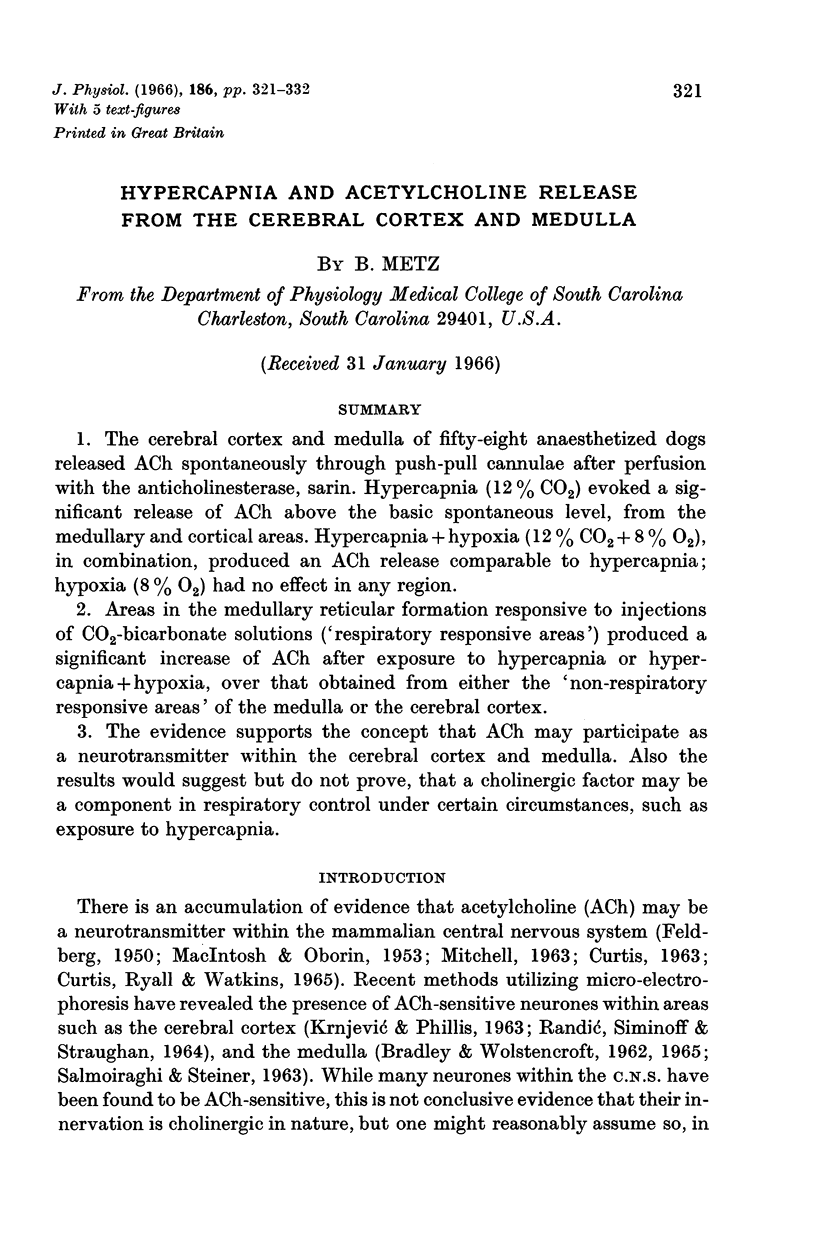
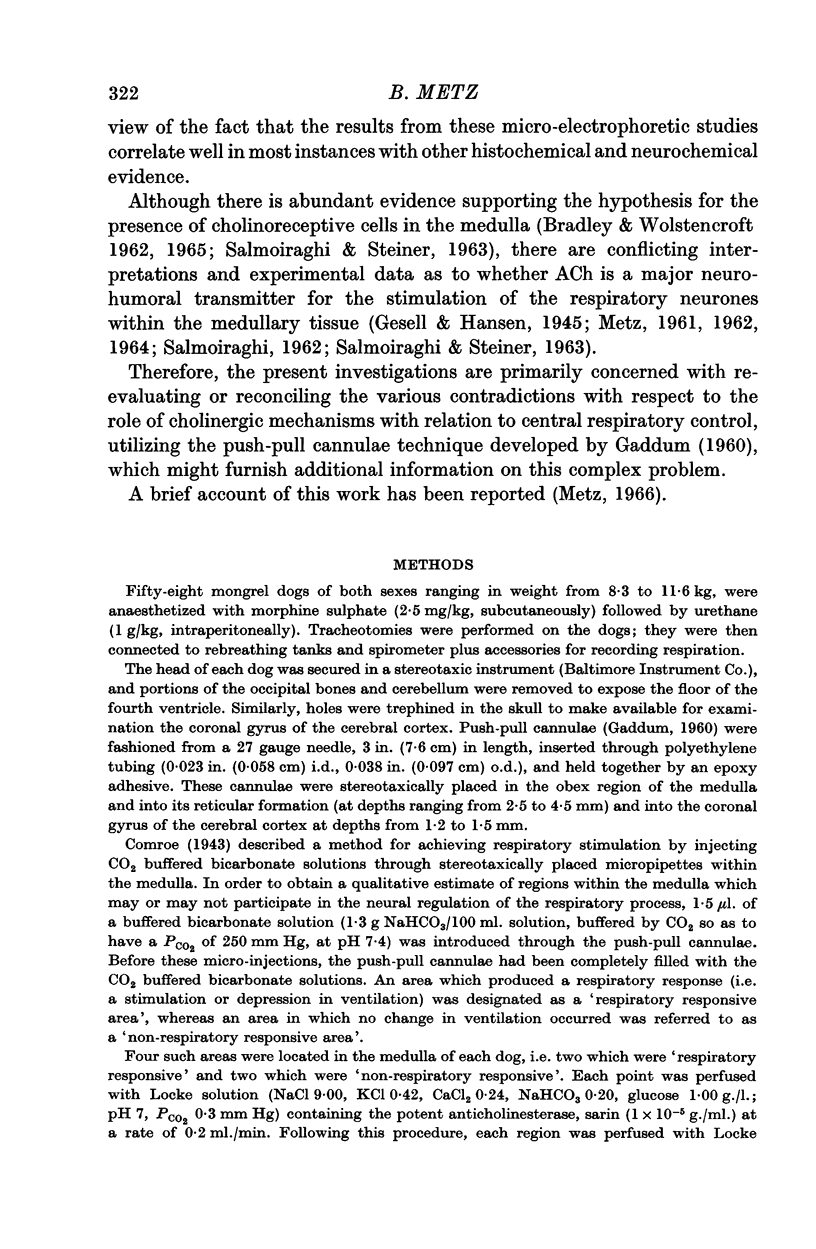
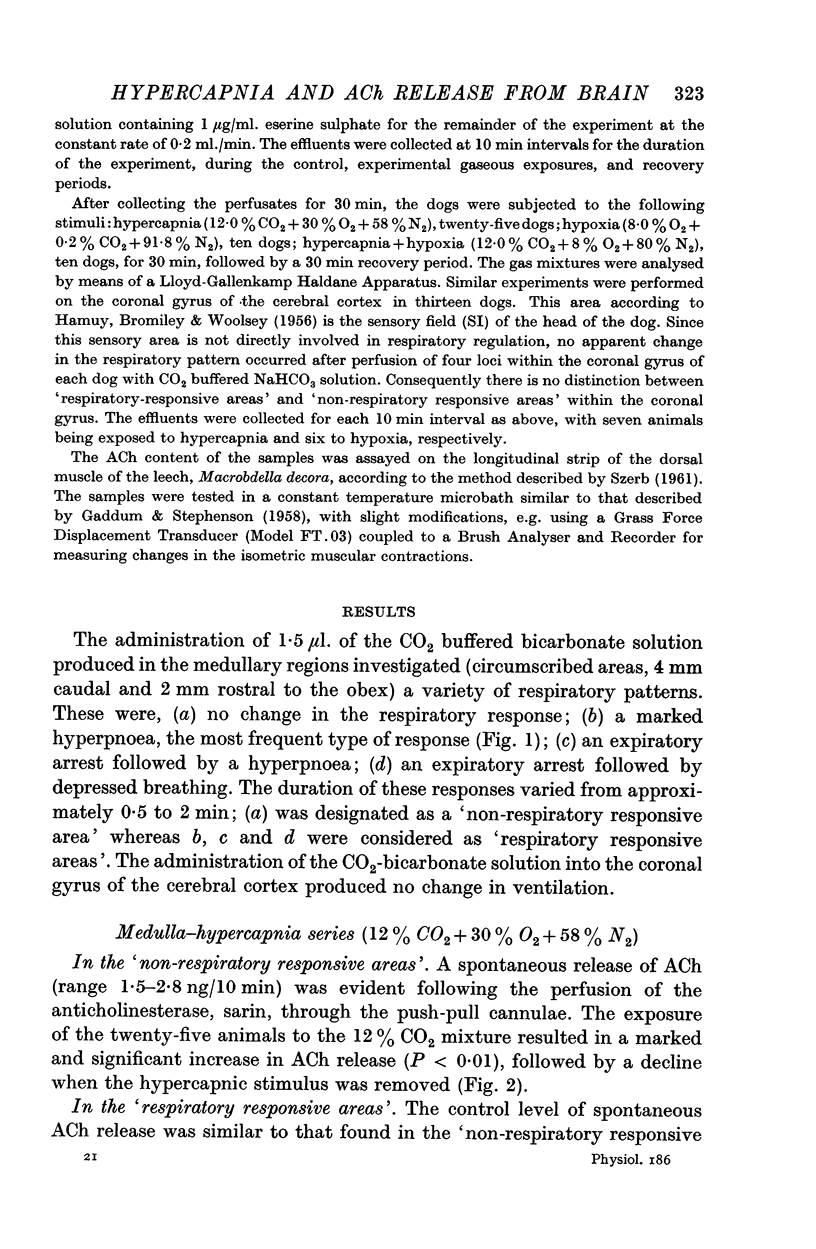
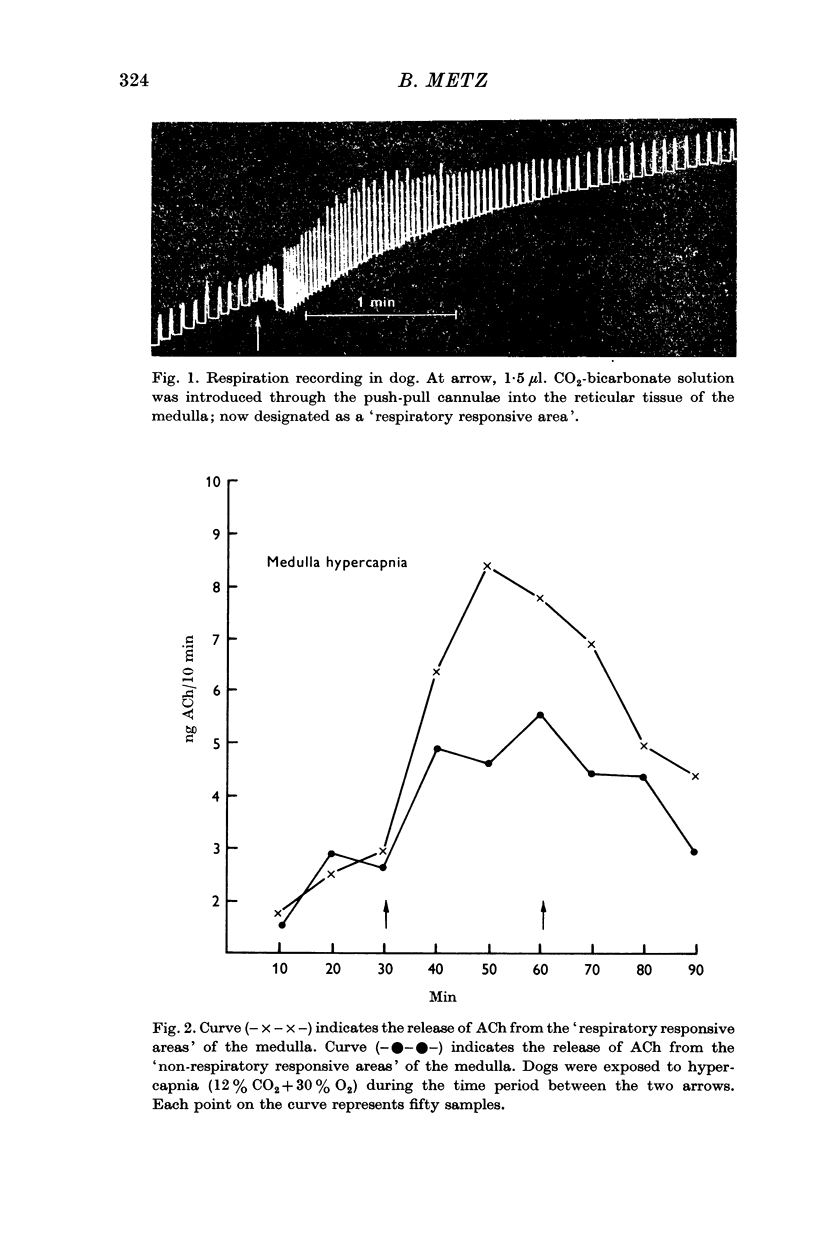
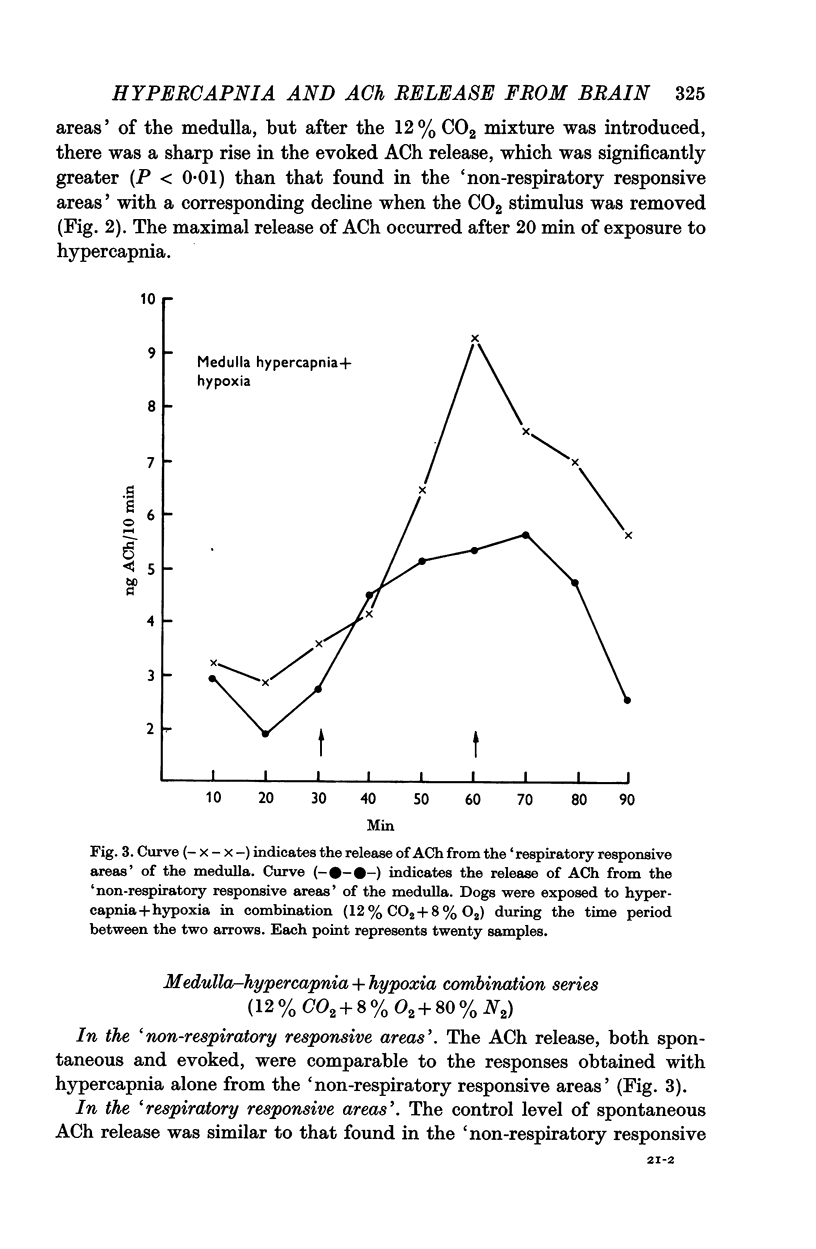
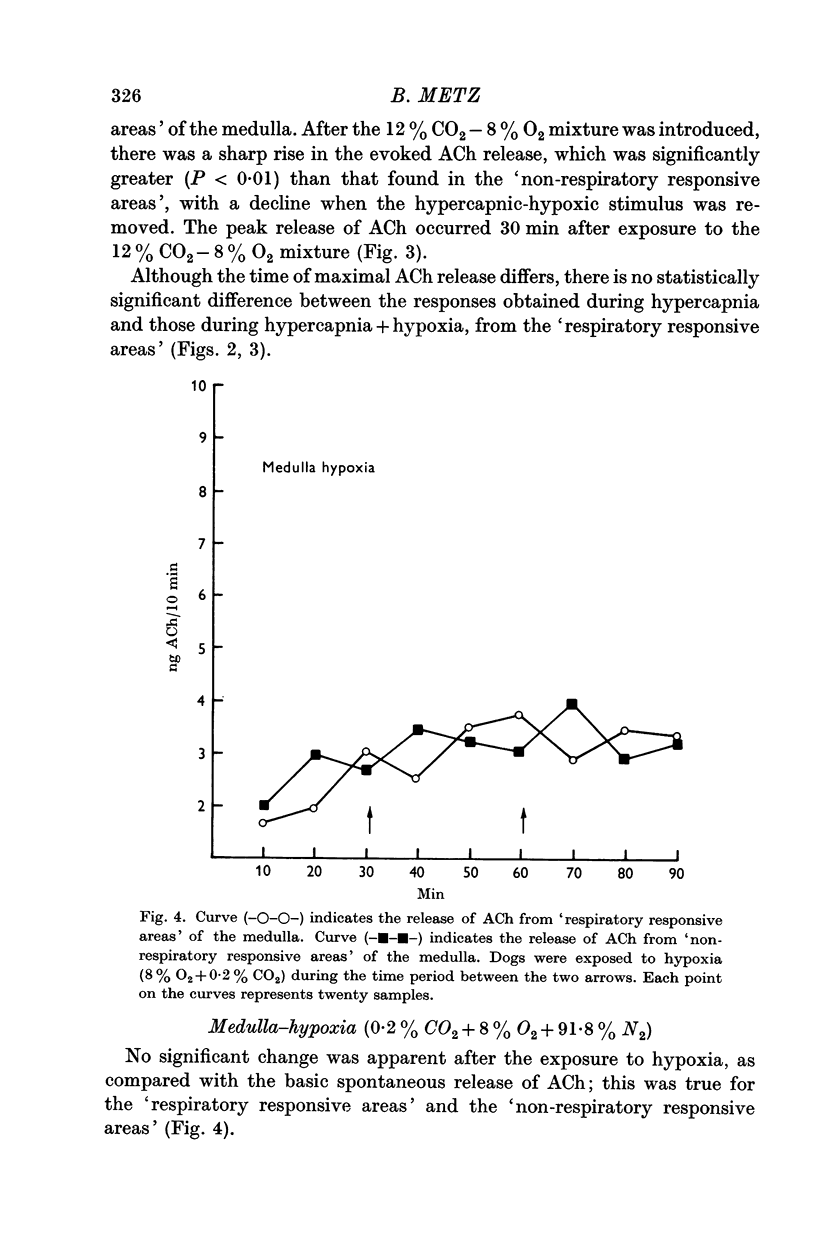
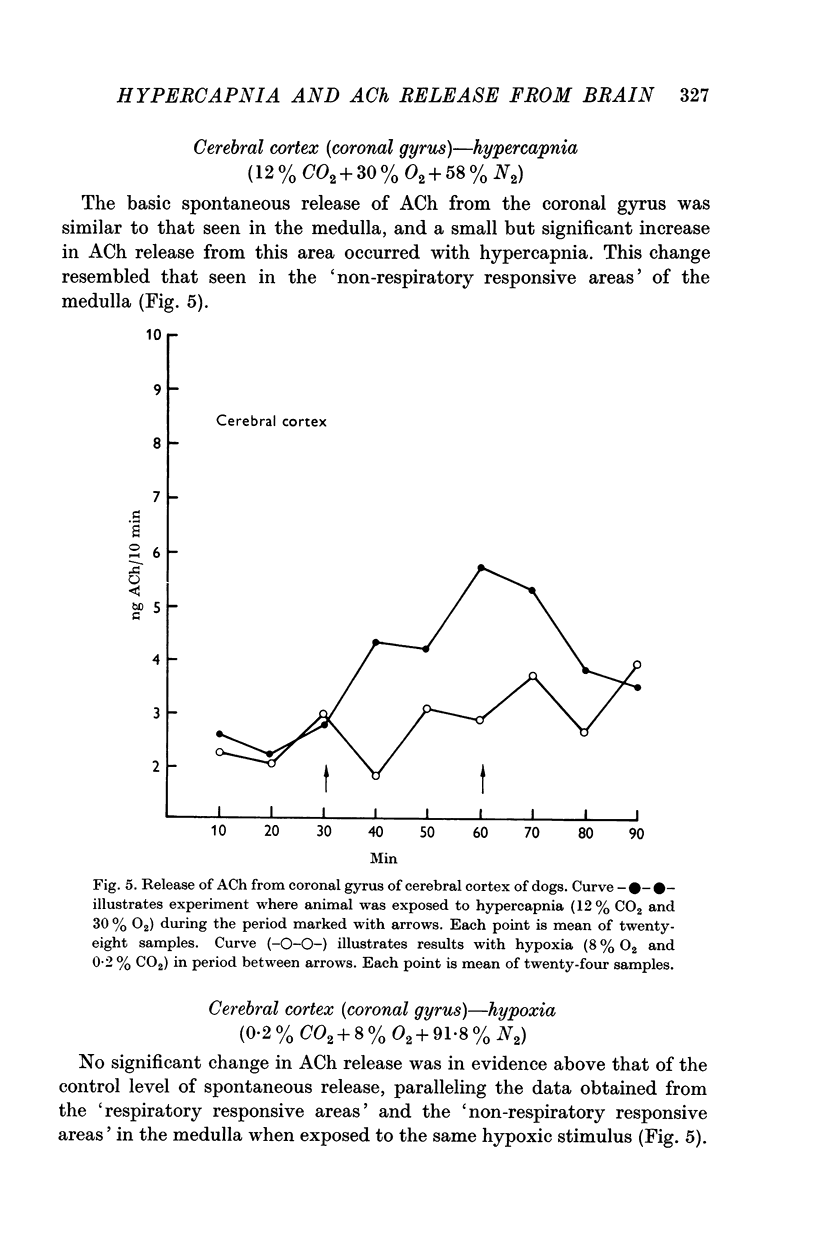
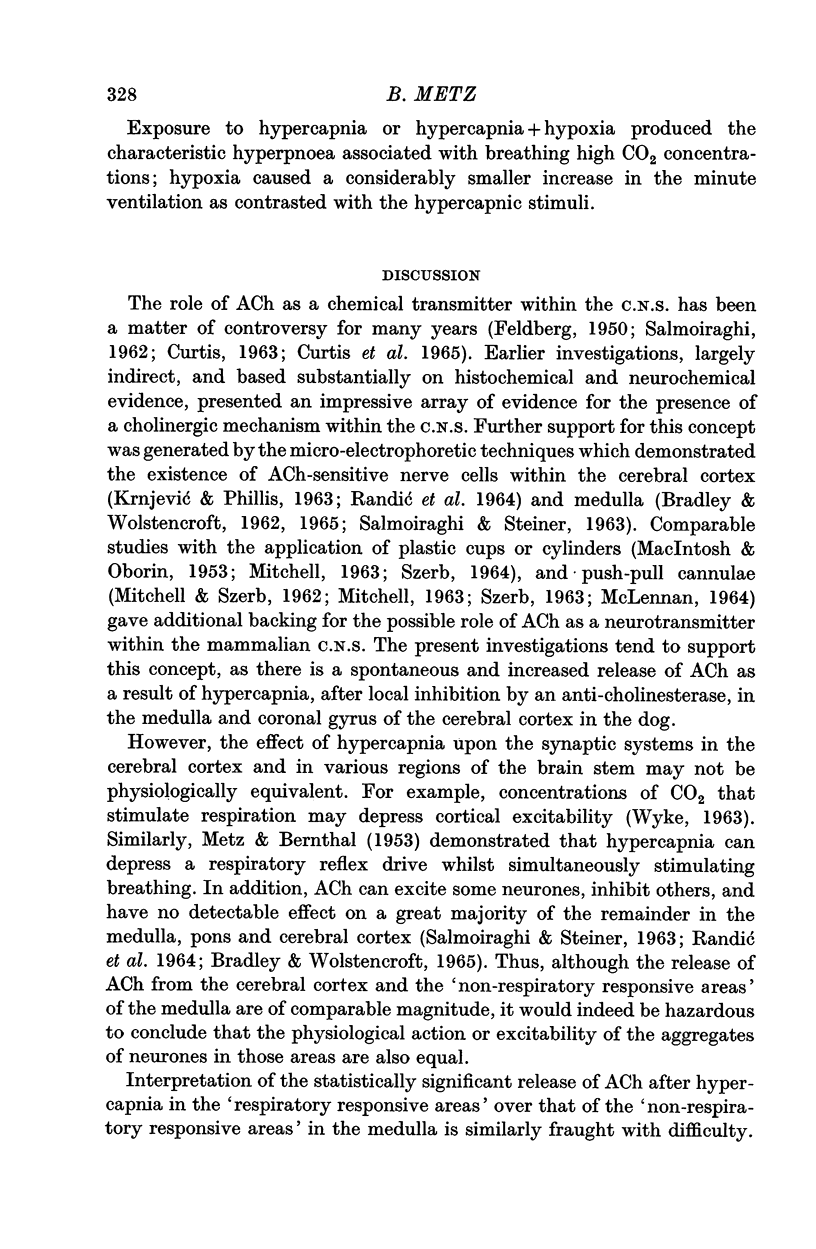
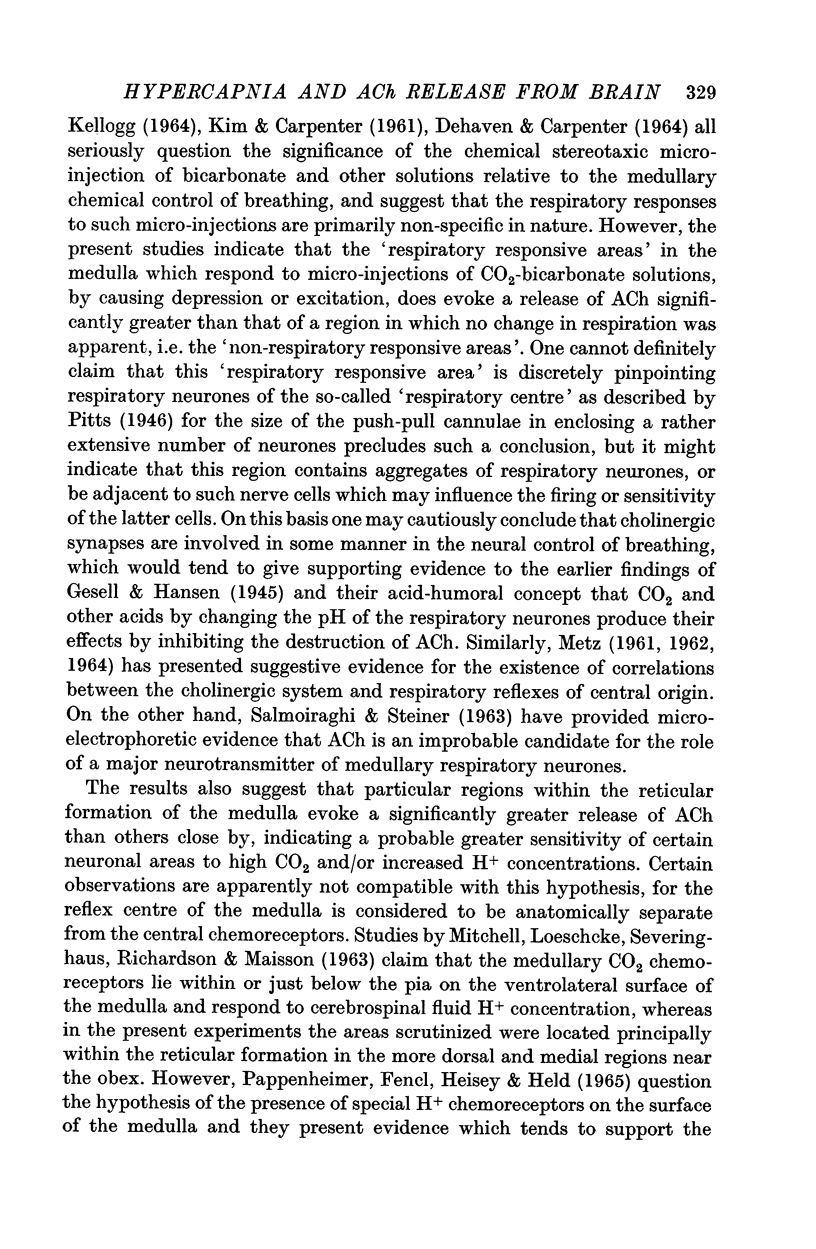
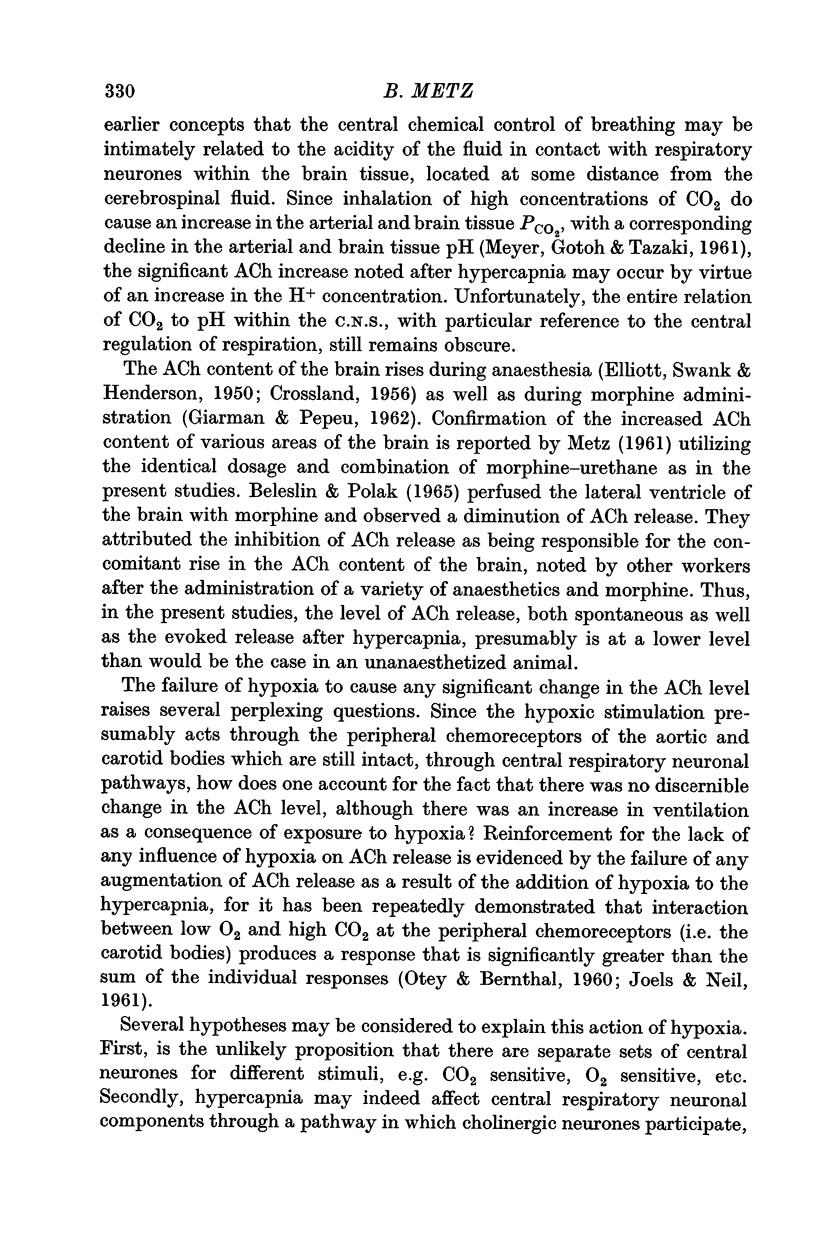
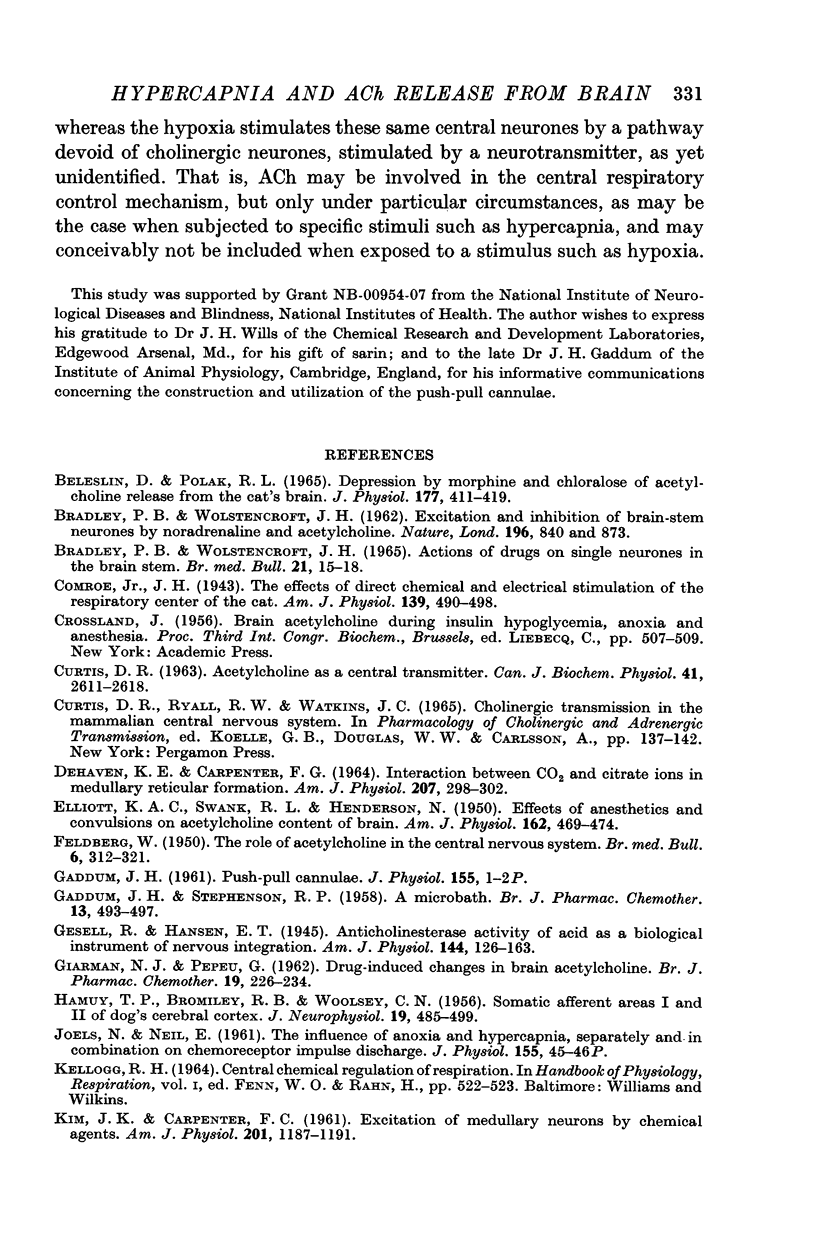
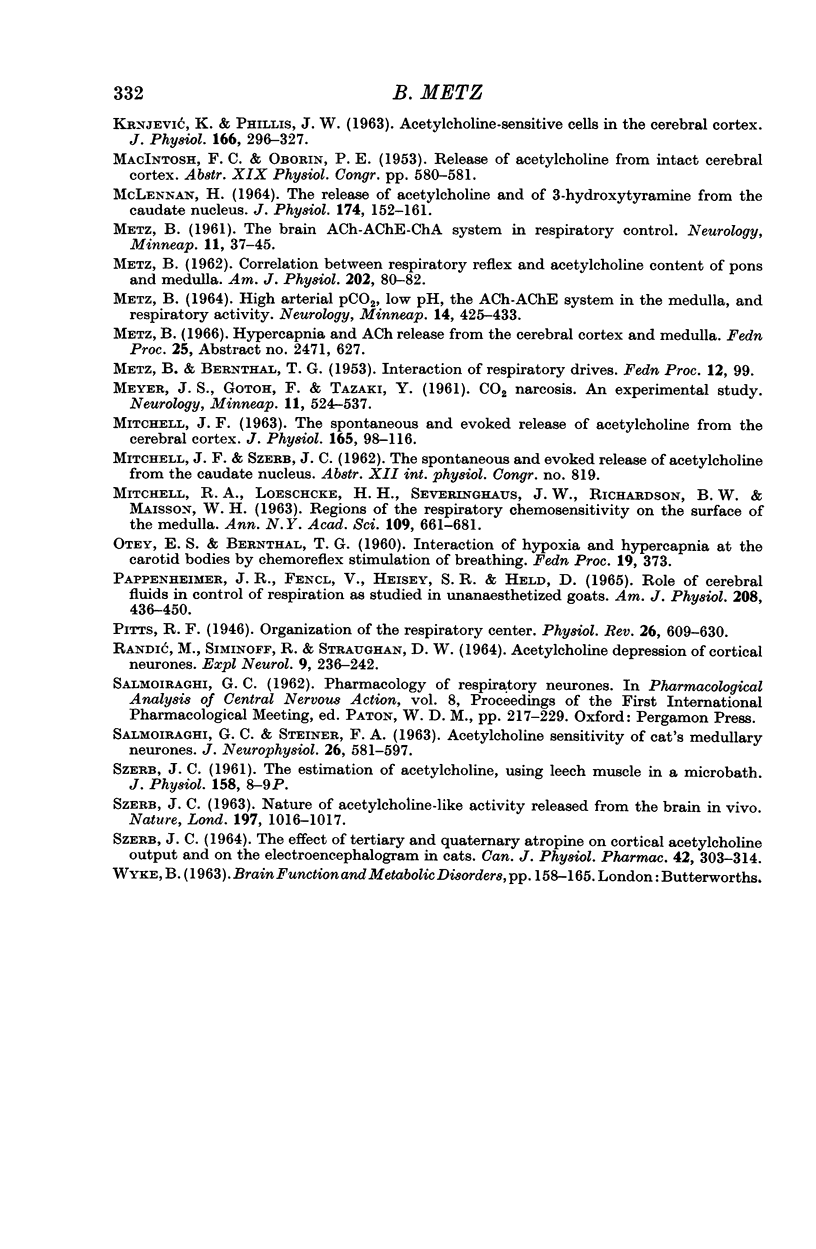
Selected References
These references are in PubMed. This may not be the complete list of references from this article.
- BELESLIN D., POLAK R. L. DEPRESSION BY MORPHINE AND CHLORALOSE OF ACETYLCHOLINE RELEASE FROM THE CAT'S BRAIN. J Physiol. 1965 Apr;177:411–419. doi: 10.1113/jphysiol.1965.sp007600. [DOI] [PMC free article] [PubMed] [Google Scholar]
- BRADLEY P. B., WOLSTENCROFT J. H. ACTIONS OF DRUGS ON SINGLE NEURONES IN THE BRAIN-STEM. Br Med Bull. 1965 Jan;21:15–18. doi: 10.1093/oxfordjournals.bmb.a070349. [DOI] [PubMed] [Google Scholar]
- BRADLEY P. B., WOLSTENCROFT J. H. Excitaion and inhibition of brain-stem neurones by noradrenaline and acetylcholine. Nature. 1962 Dec 1;196:840–passim. doi: 10.1038/196840a0. [DOI] [PubMed] [Google Scholar]
- BROMILEY R. B., PINTO HAMUY T., WOOLSEY C. N. Somatic afferent areas I and II of dog's cerebral cortex. J Neurophysiol. 1956 Nov;19(6):485–499. doi: 10.1152/jn.1956.19.6.485. [DOI] [PubMed] [Google Scholar]
- CURTIS D. R. ACETYLCHOLINE AS A CENTRAL TRANSMITTER. Can J Biochem Physiol. 1963 Dec;41:2611–2618. [PubMed] [Google Scholar]
- DEHAVEN K. E., CARPENTER F. G. INTERACTION BETWEEN CO2 AND CITRATE IONS IN MEDULLARY RETICULAR FORMATION. Am J Physiol. 1964 Aug;207:298–302. doi: 10.1152/ajplegacy.1964.207.2.298. [DOI] [PubMed] [Google Scholar]
- ELLIOTT K. A. C., SWANK R. L., HENDERSON N. Effects of anesthetics and convulsants on acetylcholine content of brain. Am J Physiol. 1950 Aug 1;162(2):469–474. doi: 10.1152/ajplegacy.1950.162.2.469. [DOI] [PubMed] [Google Scholar]
- FELDBERG W. The role of acetylcholine in the central nervous system. Br Med Bull. 1950;6(4):312–321. doi: 10.1093/oxfordjournals.bmb.a073622. [DOI] [PubMed] [Google Scholar]
- GADDUM J. H., STEPHENSON R. P. A microbath. Br J Pharmacol Chemother. 1958 Dec;13(4):493–497. doi: 10.1111/j.1476-5381.1958.tb00244.x. [DOI] [PMC free article] [PubMed] [Google Scholar]
- GIARMAN N. J., PEPEU G. Drug-induced changes in brain acetylcholine. Br J Pharmacol Chemother. 1962 Oct;19:226–234. doi: 10.1111/j.1476-5381.1962.tb01184.x. [DOI] [PMC free article] [PubMed] [Google Scholar]
- KIM J. K., CARPENTER F. G. Excitation of medullary neurons by chemical agents. Am J Physiol. 1961 Dec;201:1187–1191. doi: 10.1152/ajplegacy.1961.201.6.1187. [DOI] [PubMed] [Google Scholar]
- KRNJEVIC K., PHILLIS J. W. Acetylcholine-sensitive cells in the cerebral cortex. J Physiol. 1963 Apr;166:296–327. doi: 10.1113/jphysiol.1963.sp007106. [DOI] [PMC free article] [PubMed] [Google Scholar]
- MARLEY E., PATON W. D. The output of sympathetic amines from the cat's adrenal gland in response to splanchnic nerve activity. J Physiol. 1961 Jan;155:1–27. doi: 10.1113/jphysiol.1961.sp006610. [DOI] [PMC free article] [PubMed] [Google Scholar]
- MCLENNAN H. THE RELEASE OF ACETYLCHOLINE AND OF 3-HYDROXYTYRAMINE FROM THE CAUDATE NUCLEUS. J Physiol. 1964 Oct;174:152–156. doi: 10.1113/jphysiol.1964.sp007478. [DOI] [PMC free article] [PubMed] [Google Scholar]
- METZ B. Correlation between respiratory reflex and acetylcholine content of pons and medulla. Am J Physiol. 1962 Jan;202:80–82. doi: 10.1152/ajplegacy.1962.202.1.80. [DOI] [PubMed] [Google Scholar]
- METZ B. HIGH ARTERIAL PCO2, LOW PH, THE ACH-ACHE SYSTEM IN THE MEDULLA, AND RESPIRATORY ACTIVITY. Neurology. 1964 May;14:425–433. doi: 10.1212/wnl.14.5.425. [DOI] [PubMed] [Google Scholar]
- METZ B. The brain ACh-AChE-ChA system in respiratory control. Neurology. 1961 Jan;11:37–45. doi: 10.1212/wnl.11.1.37. [DOI] [PubMed] [Google Scholar]
- MEYER J. S., GOTOH F., TAZAKI Y. CO2 narcosis. An experimental study. Neurology. 1961 Jun;11:524–537. doi: 10.1212/wnl.11.6.524. [DOI] [PubMed] [Google Scholar]
- Mitchell J. F. The spontaneous and evoked release of acetylcholine from the cerebral cortex. J Physiol. 1963 Jan;165(1):98–116. doi: 10.1113/jphysiol.1963.sp007045. [DOI] [PMC free article] [PubMed] [Google Scholar]
- PAPPENHEIMER J. R., FENCL V., HEISEY S. R., HELD D. ROLE OF CEREBRAL FLUIDS IN CONTROL OF RESPIRATION AS STUDIED IN UNANESTHETIZED GOATS. Am J Physiol. 1965 Mar;208:436–450. doi: 10.1152/ajplegacy.1965.208.3.436. [DOI] [PubMed] [Google Scholar]
- RANDIC M., SIMINOFF R., STRAUGHAN D. W. ACETYLCHOLINE DEPRESSION OF CORTICAL NEURONS. Exp Neurol. 1964 Mar;9:236–242. doi: 10.1016/0014-4886(64)90020-2. [DOI] [PubMed] [Google Scholar]
- SALMOIRAGHI G. C., STEINER F. A. Acetylcholine sensitivity of cat's medullary neurons. J Neurophysiol. 1963 Jul;26:581–597. doi: 10.1152/jn.1963.26.4.581. [DOI] [PubMed] [Google Scholar]
- SZERB J. C. Nature of acetylcholine-like activity released from brain in vivo. Nature. 1963 Mar 9;197:1016–1017. doi: 10.1038/1971016a0. [DOI] [PubMed] [Google Scholar]
- SZERB J. THE EFFECT OF TERTIARY AND QUATERNARY ATROPINE ON CORTICAL ACETYLCHOLINE OUTPUT AND ON THE ELECTROENCEPHALOGRAM IN CATS. Can J Physiol Pharmacol. 1964 May;42:303–314. doi: 10.1139/y64-036. [DOI] [PubMed] [Google Scholar]


